Kotel Tunnels and Ramparts Walk
We spent two full days exploring Jerusalem two weeks ago. So much is packed into the streets of this ancient wall enclosed-city I decided to break our trip down into smaller snippets which highlight different experiences during our time there. In this first post I want to relate two contrasting tours, which also marked the beginning and end of our weekend in Jerusalem: the Kotel Tunnels of the Western Wall and the Ramparts Walk.
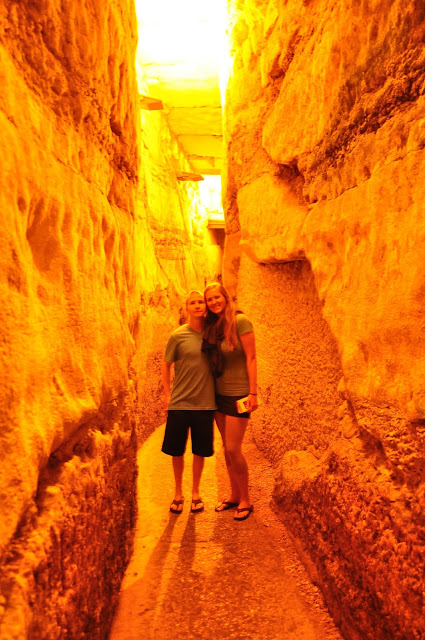 |
| In the northern section of the Kotel Tunnels where bedrock presides over cut stone. |
I must give
Globetrekker its due, as I learned about both of these tours from one of their travel documentaries. I will start with the Kotel Tunnels as this was our first stop in Jerusalem on Thursday evening and was our introduction to the architecture and history of the Old City.
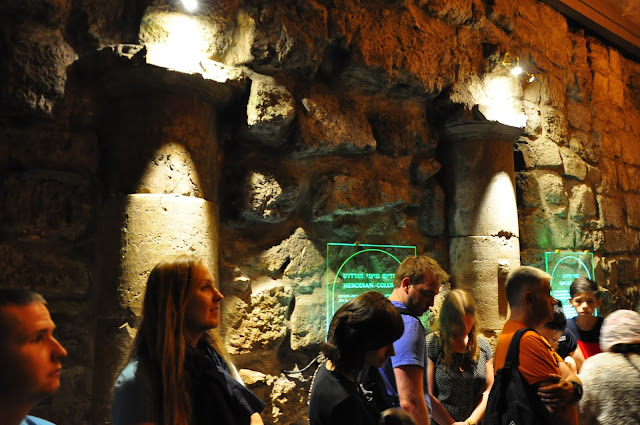 |
| Listening as our tour guide explains this section of tunnels was a street adjacent to the Temple Mount before the Romans encased it in arches to make a platform for the city above. |
As described in the Bible, Jerusalem is a city built on two hills. Today it is difficult to pick out these hills of Jerusalem as engineering of Herod the Great/Herod the Builder flattened much of the area. This is the same paranoid Herod who built
Masada. What Herod began the Romans finished, but I will get to that later.
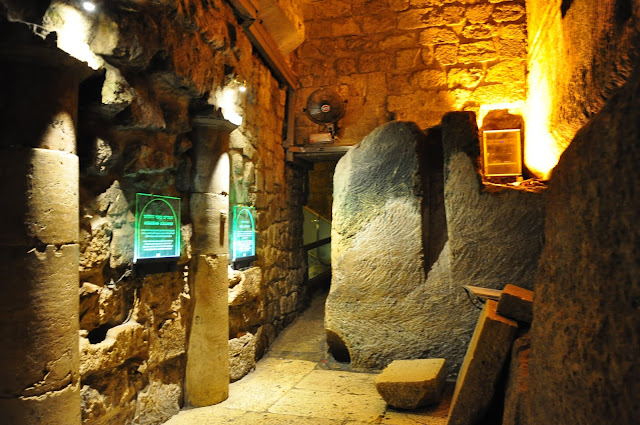 |
| The end of the tunnels, once a street, where paving stones still lie when workers abandoned them when the Romans attached Jerusalem. An aqueduct on the far end leads to a large water retention pool. |
Herod decided to appease his people who hated him so direly for all his mass murdering by building the grandest temple to house the Ark of the Covenant. Coincidentally the previous temple had been destroyed and needed to be replaced anyways. The hills of Jerusalem posed a problem for his grand design, which needed a flat surface. So he lopped the top of one of the hills and built up a platform in the adjacent valley making a large flat surface now known as the Temple Mount.
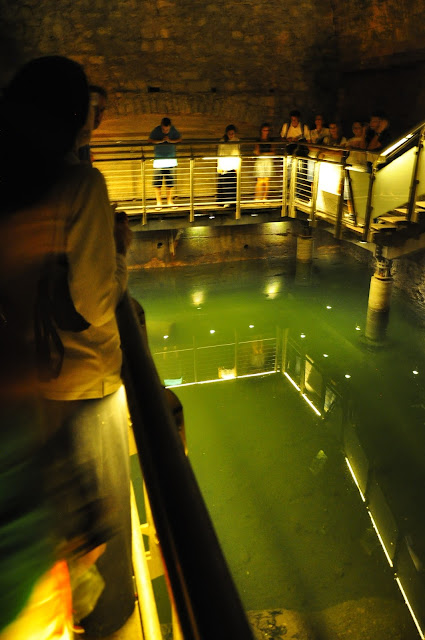 |
| A water retention pool that once supplied drinking water to Jerusalem. This pool is separated from its greater portion (three quarters of it) which lie on the other side of the far wall in the Muslim Quarter. Residents of that quarter built the wall to prevent unwanted visitors. |
Today the Temple Mount is home to the Dome of the Rock controlled by the Muslim Quarter of Jerusalem and the western side of the mount is home to the Wailing Wall where Jews come to pray for the rebuilding of the temple among whatever other concerns they have for God.
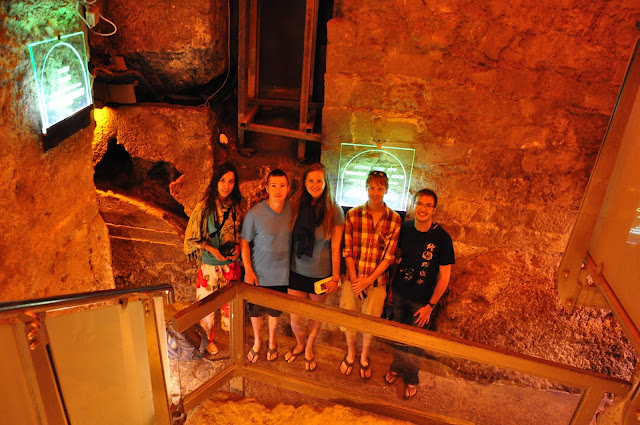 |
| Posing for a photo with my friends in the southern part of the tunnels where the Western Wall (behind us) is dominated by Herodian masonry over shaped bedrock. |
The Romans, talented architects and builders themselves decided to continue Herod's flattening of the area after they conquered Jerusalem by buliding a large platform on which to build a city to the west of Herod's Temple Mount, where a valley dipped the elevation. Arch after arch was constructed on which a large level surface was placed, running all the way to the Western Wall of the Temple Mount. It is through these arches under the city platform, adjacent to the Western Wall that our first tour took place.
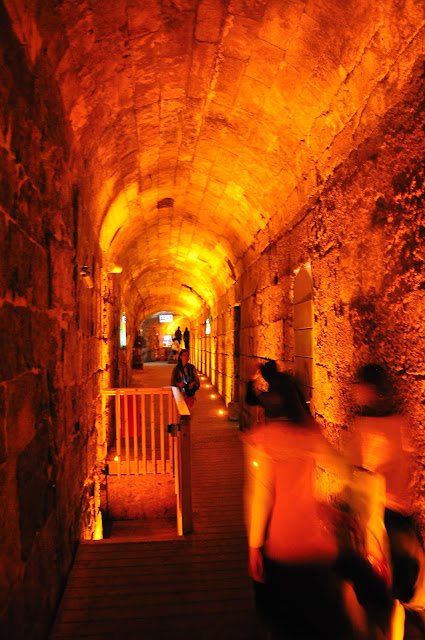 |
| The way into the Kotel tunnels, a tunnel which runs from the Western Wall to the ticket office near the entrance to the Western Wall square. |
The tunnels were only recently excavated, after the Six Day War of 1967. Now visitors, led by a tour guide for only 30 NIS (~8 USD) can see the impressive architecture of this hidden world. As part of our tour, we saw Herodian architecture contrast against Roman architecture as the style of stone construction changed. We saw massive rooms defined by arches that are being converted to prayer rooms for Jews to pray close to where the Holy of Holies once stood.
I think (and I am sure my friends on the tour would agree) the best part of the tour was learning about and seeing the large Herodian base stones that support the wall. These stones are 39 feet wide, 12 feet tall, and 12 feet thick. When much of the Old City tumbled around them as stones cracked during earthquakes, the Herodian base stones remained intact retaining the support of the Temple Mount. An even more impressive fact about these stones is that they are so heavy, a modern day crane could not pick them up. How the stones were hoisted into place thousands of years ago no one knows.
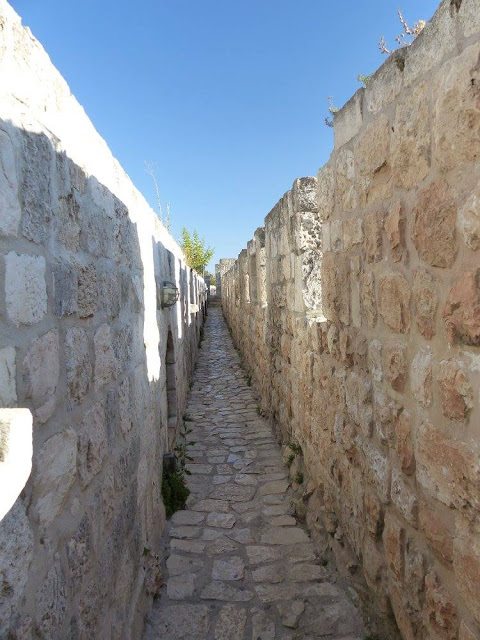 |
| The Rampart's Walk of the Old City of Jerusalem |
In contrast to the Kotel Tunnels which was how we initiated our trip to Jerusalem, we ended our trip to the Old City with a stroll on the Rampart's Walk. The Rampart's Walk is a self-led walk along the apex of the Old City's enclosing wall. Two sections of the walk exist, both of which originate at Jaffa Gate. We explored the southern section of the ramparts as it was the section open on Saturday evening.
The group of us paid our 16 NIS fees at the entrance near the Citadel of David, climbed a set of metal stairs, and leisurely strolled among the ramparts almost all the way to the Western Wall where the walk ended. In comparison to the Kotel Tunnels which Jewish heritage organizations have worked hard to make accessible and easy to walk on, the ramparts proved tricky at times, with steep stairs, stones worn slippery by constant exposure to the elements, and uneven paving. Although annoying at times, it left me feeling an "authentic" experience.
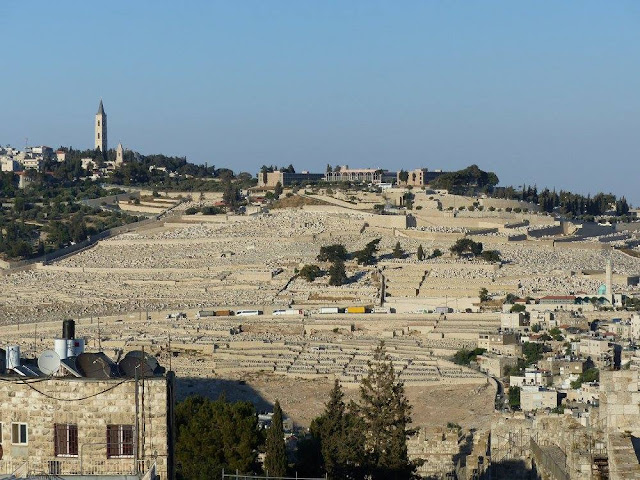 |
| The Mount of Olives as viewed form the Rampart's Walk near the Western Wall. |
In a way the Rampart's Walk was a nice way to end our trip to Jerusalem. We were able to view from above many of the historic buildings, streets, and walls we had learned about over the past couple of days. I had heard our guide say repeatedly how Jerusalem was well situated for defense because of the valleys and walls that surrounded it. I did not realize how effective of a defensive position Jerusalem truly inherited until I peered over the ramparts at the streets into the valley below. Any army attacking would have had a difficult time advancing up and over a wall perched above such a steep valley.
One last advantage to ending our trip on the city walls, was that we yet again were able to view areas of the city mostly hidden from view previously, such as much of the Armenian Quarter undeveloped and surrounded by its own wall within the Old City.


I guess you had a nice time in Jerusalem. Whenever I have to plan my journey I take advises of my family members. They help me plan my expenses and everything else. They helped me buy Sweden Road Map for my vacation in Sweden and thanks to them that I had an awesome journey, exploring the beauty of Sweden.
ReplyDelete